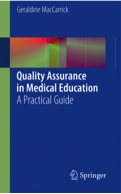 In today’s evolving global healthcare landscape, it is imperative that the content and delivery of medical curricula be dynamically matched to local requirements while retaining a world-class standard. The focus of medical schools is shifting from lecturer to student, from teaching to learning, from didactic to problem-oriented, and even the most hidebound ivory towers of clichéd medical tradition are perforce conforming to this change.
In today’s evolving global healthcare landscape, it is imperative that the content and delivery of medical curricula be dynamically matched to local requirements while retaining a world-class standard. The focus of medical schools is shifting from lecturer to student, from teaching to learning, from didactic to problem-oriented, and even the most hidebound ivory towers of clichéd medical tradition are perforce conforming to this change.
Barriers to introspection and restructuring include deficits of momentum, leadership, program oversight, resources and bolstering evidence. Medical faculty faced with the daunting prospect of preparing for institutional accreditation or conducting an internal program review are likely to be unsure of how to proceed. For all such neophytes, Geraldine MacCarrick’s “Quality Assurance in Medical Education” is the vade mecum.
This book is a handy DIY manual on the process of designing and implementing a quality assured medical education program that will stand up solidly to critical introspection as well as external review for accreditation or affiliation. It tells the reader just what it is that external accrediting teams will be looking for on their visits, and lays down the principles of a comprehensive program framework without delving deep into the controversial whys and wherefores that bog down curriculum reform.
At a little over 90 pages, the book is small but reads much more coherently than some more detailed downloadable guidelines or multi-author compilations. As the subtitle specifies it is a ‘practical guide’, and this is its strength because it lays down the circumspect essentials of how to get started and provides a synoptic view of what can otherwise unwittingly extrapolate into a convoluted, counterproductive exercise. It can be read through at one sitting, ‘chewed and digested’ à la Bacon, and then reread ‘wholly, and with diligence and attention’. This handbook is also, to me, a recipe for clarity of concept that murmurs the question: ‘Why aren’t more books smaller?’
Chapters on “Getting Underway”, “Mission and Outcomes”, “The Educational Program”, “Assessment of Learning”, “Admission and Selection”, “Medical School Resources” and “Governance and Evaluation” are functionally detailed, each with a neat summary section at the end. While this book is not the standalone solution it is not intended to be, it is more than adequate to get one started and there are adequate pointers to further resources. The author has an impressive track record of educational design and reform in the medical field, and the book is firmly in line with modern principles, guidelines and requirements.
Among uninitiated medical faculty there is a xenophobic distaste for ‘management’ concepts and a passive inertial resistance to quality assurance exercises and mechanisms. These are spelt out in clear language and irrefutable logic, so succinctly that even the most diehard old-timer will be converted. Indeed the fresh brevity of the book should make it ‘required reading’ for all inductees on a QA team, to convince them that accreditation and review exercises are not millstones but milestones, not ‘threats’ but opportunities to ‘drive forward the quality improvement agenda’. Veterans of medical education too will benefit from the renewal of thought that this précis affords and, given the high “benefit-cost ratio” of a book this readable, so will the casual professional.
(The reviewer is Quality Assurance Officer, SSR Medical College, Mauritius)
Dr. Sushil Dawka
Professor of Surgery,
SSR Medical College,
Mauritius
Email: sushil.dawka@gmail.com